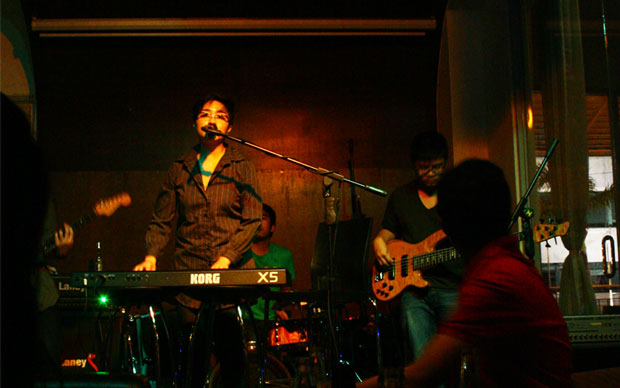
A different sound. Critically acclaimed band Up Dharma Down pleases the crowd in a well-attended gig at Makati last July 9. Photo by Aih Mendoza.
In the Ateneo, as in any other place called home by an eclectic community of music lovers, rock music dominates the scene.
This is evident in the officially recognized commune of musicians in campus, the Ateneo Musician’s Pool (AMP). This 15-year-old “home org” of Atenean bands, which was originally established so that “Ateneo bands would be treated fairly when they are hired for gigs or shows,” has grown over the years to become an avenue through which musically inclined Ateneans can share their interests, hone their skills and help each other out.
Though she is careful not to give a definite answer, AMP President Mary Anne Collantes says, “I guess the most dominant [genre in AMP] would be rock.” She explains that the different acts in AMP, while each varying in style, all still have that distinct rock element in their music.
But despite rock’s exalted position across college music scenes, a lot of other music genres still thrive in the Ateneo. From Fuzz’s fusion of jazz and funk to Reese & Vica’s whimsical compositions, it is clear that the Ateneo music scene has been a welcoming home for musical experimentation.
“The genres in AMP are quite diverse,” Collantes says. “There’s a lot of pop, blues and jazz as well. At first I thought that Ateneans like rock and rock alone, so I was surprised to see the amount of diversity in music taste.”
The thriving music scene in campus is a picture of vivacity and prolificacy, and one would be forgiven to expect the same from the wider community of local musicians. In reality, though, not all is well in the Filipino music scene. Music, perhaps the most accessible of all art forms, has had to face immense challenges in the Philippine setting.
Recent developments
Last January, one of the top local bands in recent years, Bamboo, ended its nine-year journey. Two months later, another local favorite, Sugarfree, held its farewell concert in the Eastwood City grounds. Prior to this, other noted acts such as Hale and the Rico Blanco-fronted Rivermaya also vanished from the scene.
These acts were among the main movers during the resurgence of Pinoy rock during the first decade of the new millennium.
In addition, NU107, the leading rock music station in the country, signed off for the last time last November 7, 2010. During this local rock favorite’s final broadcast, its most loyal listeners were gathered outside the station’s studio, holding candles and tearing up while the station played the Eraserheads’ “Ang Huling El Bimbo” as its last song.
“The music industry is having a hard time in staying afloat. Gig places are closing down, and as we all know, NU Radio aired [its] final broadcast last year,” Collantes says. “Young people should realize how dangerous this is—the places and avenues where young musicians can show their art are slowly diminishing.”
Indeed, these are signs that indicate a decline in the industry. While Western and East Asian acts dominate the charts, local musicians are grappling with the challenge of winning appreciation for their art, even with the increasingly indifferent environment.
Definitions
All this necessitates a question: what is local music?
The term “original Pinoy music” (OPM) has been one way to refer to local music for a long time now, having been identified as a distinct genre around 30 years ago. It increasingly gained prominence during the 1980s, with an upbeat local music industry warding foreign labels’ repeated attempts to dominate the scene.
With the emergence of a wider variety of local music in the last decade, though, the defining characteristics of OPM seem harder to identify.
For Toti Dalmacion, founder of Terno Recordings and quite the superstar in the local indie music crowd, identifying which local acts are both truly “original” and truly “Pinoy” is a daunting task.
“It’s hard to pin down the real OPM these days,” he says. “In the 70s, it was really easy because [the term] was new—either an act is foreign or [Filipino].”
It’s not the same thing for the contemporary music scene. “We have bands who are original in the sense that they do not sound like anyone else, [but] other than that, it’s hard to tell [what OPM is nowadays],” says Dalmacion.
Meanwhile, for Arwin Tan, an Interdisciplinary Studies lecturer for the Minor in Music Literature course, contemporary OPM is very reflective of Western pop music in terms of musicality and scale.
However, he notes that there is a tendency to define OPM as being composed by a Filipino, and being written in a Filipino. Tan believe that this definition is a common misunderstanding of OPM.
Indeed, such a definition would seem problematic when one takes into consideration the fact that in local music channels, there is an abundance of foreign songs covered by local artists and of original Filipino-produced songs written in English.
In this regard, Dino Concepcion, the vocalist of the local alternative reggae band Brownman Revival, offers a more inclusive definition of OPM. He says that OPM is any kind of music that “expresses the sentiments, tastes, peculiarities, and everyday experiences of common Filipinos.”
Going commercial
It seems, though, that a certain environment—the market—has had a particularly detrimental effect on music.
Tan accepts that OPM has a dimension that cannot be discounted: it is funded and produced mainly for commercial purposes. OPM naturally conforms to pressures in the market in order to be deemed worthy of funding or of being played in commercial music stations.
He notes, though, that commerciality is not necessarily bad, because in the Philippine setting, as in most other parts of the world, music is viewed as an industry. He mentions The Dawn and Bamboo as examples of commercial bands that still manage to produce good music.
Dalmacion, on the other hand, thinks that there is nothing wrong with the commercial aspect of producing music as long as the identity and musical style of the musicians are respected. His small record company, for example, is famed for producing the music of critically acclaimed acts Up Dharma Down and the Radioactive Sago Project.
“In every city and every country, there is an underground and a commercial,” Dalmacion explains. “In the Philippines, I am in between the two. [In Terno Recordings], there were never [impositions on] the bands to adjust their music for it to sell.”
Concepcion also agrees that OPM is of a “commercial category” in the music industry, but he is optimistic that Filipinos do not solely consume music as articles of trade.
“It is true that profit-driven culture industries create music as commodities, and that [these commodities] reinforce the hegemony of a dominant class’ cultural ideology,” he says, offering a more critical view of the market’s grip on music. “But these do not, in absolute terms, amount to Filipinos consuming music as commodities or subscribing to the promoted ideology.”
Commoditizing music
But if Dalmacion’s observations about the dominant music scene in the Philippines are taken into account, it seems that for most Filipinos, music is indeed a commodity, in the way Concepcion defines it. And the market’s grip on music is all too strong.
“The problem with us is that it’s all about money,” Dalmacion laments. “That’s why [music] never changes that much.”
Indeed, given the top commercial record companies’ strong grip on the industry, and thus their capability to even dictate the masa’s tastes in music, there is a cycle wherein the same old music is repeatedly produced, since the top record companies want to maintain what is, for them, a profitable status quo. The ground therefore becomes hostile to alternative kinds of music.
“It’s a cycle,” Dalmacion says.
Hitting the right tunes
When good music does not make a killing at the market, the market tends to kill it instead. After all, radio frequency 107.5 turned from tasteful to trashy because going mainstream seemed a lot more lucrative for NU107’s operators.
Fortunately, a bright spot remains in the colorful scene of local music—local indie musicians passionate about their craft don’t see the status quo as an inescapable reality. Musicians don’t always let the market define them.
This is an important difference between local indie music and commercial OPM. Tan says, “It is enough for [indie musicians] to have a small following, and they cater to and take care of this niche.”
He explains further: “Culturally speaking, [indie musicians] contribute more to our society. I like that they maintain their cultural integrity.”
Collantes agrees. “Wonderful talent can be found by listening to Philippine indie music,” she says. “It’s great to see that even in these musically [difficult] times, there are a lot of new indie bands that are growing and developing.”
While a lot of people would rather just leave the fate of the arts to the market, there are still those who see music as an art worth fighting for.
“It needs to be fought for—that ‘real’ music,” Collantes says. “Music is not just entertainment… It is an important form of art. We need to save it and make sure that it lives on.”
With reports from Luther B. Aquino
- A different sound. Critically acclaimed band Up Dharma Down pleases the crowd in a well-attended gig at Makati last July 9. Photo by Aih Mendoza.










